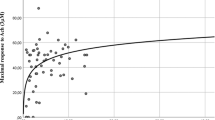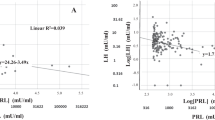Abstract
The role of low testosterone levels in erectile dysfunction (ED) remains unclear. Both organic and psychogenic factors contribute to ED, with vasculogenic causes being the most common etiology. Approximately 10–20% of patients with ED are diagnosed with hormonal abnormalities. At the physiologic level, two second messenger systems are involved in mediating erections, one involving cyclic adenosine monophosphate (cAMP) and the other involving cyclic guanosine monophosphate (cGMP). PDE5 inhibitors such as sildenafil promote the cGMP pathway, while alprostadil affects the cAMP pathway. Evidence is strong that, in animal systems, testosterone has direct effects on erectile tissue. However, although testosterone clearly has an impact on libido in humans, its effect on penile function is less clear. Evaluation of ED includes medical, sexual, and psychosocial history assessments, as well as laboratory tests to check for diabetes and hormonal abnormalities. Initial interventions should involve correction of potentially reversible causes of ED, such as hypogonadism. First-line therapy for other patients is typically oral PDE5 inhibitors, such as sildenafil, tadalafil, or vardenafil. For patients who fail treatment with PDE5 inhibitors, local therapies such as intracavernous alprostadil are highly successful. Recent data also support the success of combination therapy with sildenafil and testosterone. This opens the possibility of other combinations of testosterone and other treatments of ED. The ability to exploit multiple pathways in the physiologic processes leading to erection may help improve therapy for ED.
This is a preview of subscription content, access via your institution
Access options
Subscribe to this journal
Receive 8 print issues and online access
$259.00 per year
only $32.38 per issue
Buy this article
- Purchase on Springer Link
- Instant access to full article PDF
Prices may be subject to local taxes which are calculated during checkout


Similar content being viewed by others
References
Kaiser FE et al. Impotence and aging: clinical and hormonal factors. J Am Geriatr Soc 1988; 36: 511–519.
Korenman SG et al. Secondary hypogonadism in older men: its relation to impotence. J Clin Endocrinol Metab 1990; 71: 963–969.
Rhoden EL, Teloken C, Mafessoni R, Souto CA . Is there any relation between serum levels of total testosterone and the severity of erectile dysfunction? Int J Impot Res 2002; 14: 167–171.
Martinez-Jabaloyas JM et al. Prognostic factors for response to sildenafil in patients with erectile dysfunction. Eur Urol 2001; 40: 641–646.
McMahon CG, Samali R, Johnson H . Efficacy, safety and patient acceptance of sildenafil citrate as treatment for erectile dysfunction. J Urol 2000; 164: 1192–1196.
Laumann EO, Paik A, Rosen RC . Sexual dysfunction in the United States: prevalence and predictors. JAMA 1999; 281: 537–544.
Feldman HA et al. Impotence and its medical and psychosocial correlates: results of the Massachusetts male aging study. J Urol 1994; 151: 54–61.
Levy A, Crowley T, Gingell C . Non-surgical management of erectile dysfunction. Clin Endocrinol (Oxf) 2000; 52: 253–260.
Padma-Nathan H, Goldstein I, Krane RJ . Evaluation of the impotent patient. Semin Urol 1986; 4: 225–232.
Donatucci CF, Lue TF . Erectile dysfunction in men under 40: etiology and treatment choice. Int J Impot Res 1993; 5: 97–103.
Whitehead ED, Klyde BJ, Zussman S, Salkin P . Diagnostic evaluation of impotence. Postgrad Med 1990; 88: 123–136.
Nickel JC et al. Endocrine dysfunction in impotence: incidence, significance and cost-effective screening. J Urol 1984; 132: 40–43.
Slag MF et al. Impotence in medical clinic outpatients. JAMA 1983; 249: 1736–1740.
Manecke RG, Mulhall JP . Medical treatment of erectile dysfunction. Ann Med 1999; 31: 388–398.
Schiavi RC, White D, Mandeli J, Levine AC . Effect of testosterone administration on sexual behavior and mood in men with erectile dysfunction. Arch Sex Behav 1997; 26: 231–241.
O'Carroll R, Bancroft J . Testosterone therapy for low sexual interest and erectile dysfunction in men: a controlled study. Br J Psychiatry 1984; 145: 146–151.
Mills TM, Lewis RW . The role of androgens in the erectile response: a 1999 perspective. Mol Urol 1999; 3: 75–86.
Buvat J, Lemaire A . Endocrine screening in 1,022 men with erectile dysfunction: clinical significance and cost-effective strategy. J Urol 1997; 158: 1764–1767.
Jain P, Rademaker AW, McVary KT . Testosterone supplementation for erectile dysfunction: results of a meta-analysis. J Urol 2000; 164: 371–375.
Shabsigh R . The effects of testosterone on the cavernous tissue and erectile function. World J Urol 1997; 15: 21–26.
Arver S et al. Improvement of sexual function in testosterone deficient men treated for 1 year with a permeation enhanced testosterone transdermal system. J Urol 1996; 155: 1604–1608.
Schultheiss D et al. Pilot study of the transdermal application of testosterone gel to the penile skin for the treatment of hypogonadotropic men with erectile dysfunction. World J Urol 2000; 18: 431–435.
Jardin A et al. Recommendations of the First International Consultation on Erectile Dysfunction. Proceedings of the International Consultation on Erectile Dysfunction, July 1999, Paris, France. http://www.issir.org/prod/data/issir/edbook/recom-en.pdf. Accessed January 9, 2003.
Hatzichristou DG et al. Sildenafil versus intracavernous injection therapy: efficacy and preference in patients on intracavernous injection for more than 1 year. J Urol 2000; 164: 1197–1200.
Shabsigh R, Kaufman JM, Steidle JM, Padma-Nathan H . Testosterone replacement therapy with testosterone gel 1% converts sildenafil nonresponders to responders in men with erectile dysfunction and hypogonadism who failed prior sildenafil therapy [abstract]. J Urol 2003; 169: 247.
Chatterjee R, Kottaridis PD, McGarrigle HH, Linch DC . Management of erectile dysfunction by combination therapy with testosterone and sildenafil in recipients of high-dose therapy for haematological malignancies. Bone Marrow Transplant 2002; 29: 607–610.
Garg R, Khaishgi A, Dandona P . Sildenafil for diabetic men with erectile dysfunction. JAMA 1999; 282: 939–941.
Barrett-Connor E, Khaw KT, Yen SS . Endogenous sex hormone levels in older adult men with diabetes mellitus. Am J Epidemiol 1990; 132: 895–901.
Tan RS, Pu SJ . Impact of obesity on hypogonadism in the andropause. Int J Androl 2002; 25: 195–201.
Shabsigh R et al. Intracavernous alprostadil alfadex is more efficacious, better tolerated, and preferred over intraurethral alprostadil plus optional actis: a comparative, randomized, crossover, multicenter study. Urology 2000; 55: 109–113.
Nehra A, Blute ML, Barrett DM, Moreland RB . Rationale for combination therapy of intraurethral prostaglandin E(1) and sildenafil in the salvage of erectile dysfunction patients desiring noninvasive therapy. Int J Impot Res 2002; 14 (Suppl 1): S38–S42.
Mydlo JH, Volpe MA, Macchia RJ . Initial results utilizing combination therapy for patients with a suboptimal response to either alprostadil or sildenafil monotherapy. Eur Urol 2000; 38: 30–34.
Author information
Authors and Affiliations
Corresponding author
Rights and permissions
About this article
Cite this article
Shabsigh, R. Hypogonadism and erectile dysfunction: the role for testosterone therapy. Int J Impot Res 15 (Suppl 4), S9–S13 (2003). https://doi.org/10.1038/sj.ijir.3901030
Published:
Issue Date:
DOI: https://doi.org/10.1038/sj.ijir.3901030
Keywords
This article is cited by
-
Sexualstörungen bei Diabetes mellitus
Der Diabetologe (2019)
-
The Gut Microbiome and Men’s Sexual Health
Current Sexual Health Reports (2019)
-
Endocrine milieu and erectile dysfunction: is oestradiol–testosterone imbalance, a risk factor in the elderly?
Asian Journal of Andrology (2011)
-
The role of hypoxia in erectile dysfunction mechanisms
International Journal of Impotence Research (2007)
-
Erectile dysfunction: Expectations beyond phosphodiesterase Type 5 inhibition
Journal of Endocrinological Investigation (2004)



